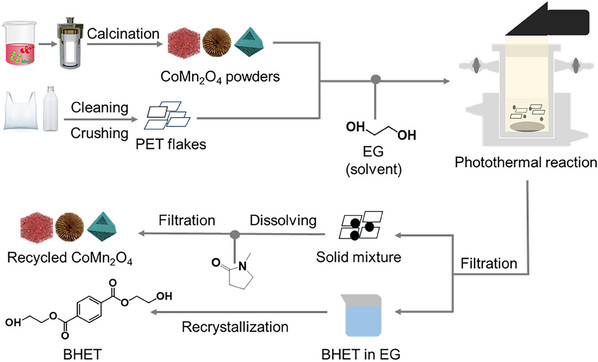Morphology Optimization of Spinel Catalysts for High-Efficiency Photothermal Catalytic Upcycling of Polyethylene Terephthalate
Juanzhang Ruan1, Qiang Cao2, Xunxun Li3, Qiuyuan Ren1, Menglong Li1, Shihong Dong4, Najun Li1, Qingfeng Xu1, Hua Li1, Jianmei Lu1(路建美)*, Dongyun Chen1(陈冬赟)*
1State Key Laboratory of Bioinspired Interfacial Materials Science College of Chemistry Chemical Engineering and Materials Science Collaborative Innovation Center of Suzhou Nano Science and Technology Soochow University Suzhou 215123, P. R. China
2Cangzhou Risun Chemicals Co. Ltd.Cangzhou, Hebei 061100, P. R. China
3Zhejiang Institute of Tianjin UniversityNingbo Key Laboratory of Green Petrochemical Carbon Emission Reduction Technology and EquipmentNingbo, Zhejiang 315200, P. R. China
4Suzhou Shijing Technology Co. Ltd.Suzhou 215137, P. R. China
Adv. Mater. 2025, 37, 2500090
Abstract: Thermocatalytic recycling of plastics is typically constrained by high energy input requirements, resulting in poor economic efficiency and necessitating the utilization of light power. Indeed, photothermal catalysis offers several advantages over traditional photocatalysis and enables more efficient use of light energy. In this study, unique octahedral spinel-structured cobalt manganese oxide (CoMn2O4) catalysts are prepared. CoMn2O4 acts as both a photothermal reagent and catalyst, demonstrating low light intensity requirements, high conversion rates, enhanced reactivity, and superior stability during polyethylene terephthalate (PET) glycolysis via photothermocatalysis. Oxygen vacancies created on CoMn2O4 facilitate PET glycolysis by providing reactive sites that promote nucleophilic addition and subsequent elimination reactions. The spinel structure of CoMn2O4 ensures high thermal stability, while the octahedral configuration enhances the optical absorption coefficient and photothermal conversion efficiency. Under identical conditions, the PET conversion efficiency of CoMn2O4 in photothermal catalysis is 3.1 times higher than under purely thermal conditions, while maintaining high selectivity for high-value monomers. This study presents a new catalyst design approach for highly efficient upcycling of plastics, highlighting its substantial potential in this field.

Article information: //doi.org/10.1002/adma.202500090